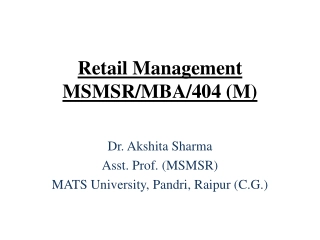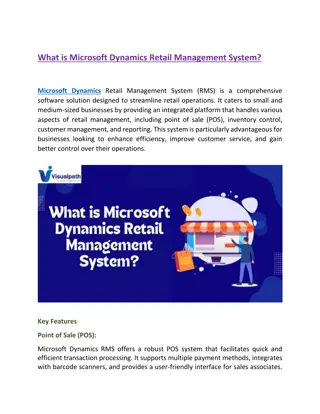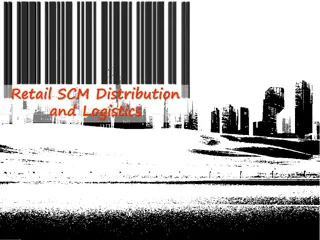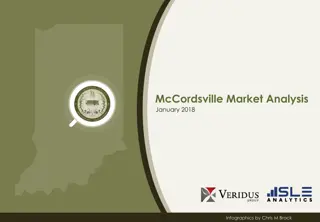Trade Area Analysis and Site Selection in Retail Management
This module delves into the importance of selecting a store location in retail management, covering topics such as environmental analysis, data analysis for location selection, and the effects of location choice on planning. It also includes activities like conducting an environmental analysis of a business and analyzing retail trading areas. Understanding the significance of location selection and its impact on short and long-term planning is emphasized throughout the content.
Download Presentation

Please find below an Image/Link to download the presentation.
The content on the website is provided AS IS for your information and personal use only. It may not be sold, licensed, or shared on other websites without obtaining consent from the author.If you encounter any issues during the download, it is possible that the publisher has removed the file from their server.
You are allowed to download the files provided on this website for personal or commercial use, subject to the condition that they are used lawfully. All files are the property of their respective owners.
The content on the website is provided AS IS for your information and personal use only. It may not be sold, licensed, or shared on other websites without obtaining consent from the author.
E N D
Presentation Transcript
Retail Management Module 6: Trade-Area Analysis and Site Selection
Learning Outcomes: Selecting a Store Location 6.1 Explain the significance of selecting a store location 6.1.1 Define environmental analysis 6.1.2 Discuss why location selection needs to involve significant analysis of data 6.1.3 Explain the effects of location choice on short and long run planning
Activity Do an environmental analysis of a business of your choice: Complete an analysis of economic factors Consider demographic and social factors Research Brand Profusion Include the Four P s of retail sales Take notes on your research and discuss with a partner where you would choose t
Data Analysis for Location Selection A retailer with excellent location has strategic advantage. When considering location, you ll want to evaluate: alternative geographic trading areas determine type of location (population, density) literacy level and educational level of populations languages spoken Are there other similar stores? What do they stock and what is their reputation?
Location Effects on Planning Knowing demographic of location is important Preparing for ebbs and flows of demographic changes is another planning option Looking at history of planned location can tell a story of the market Having ability to grow or change with the community will be important component
Learning Outcomes: Retail Trading Area 6.2 Analyze the characteristics of a retail trading area 6.2.1 List the types of demographic data a retailer can obtain from the U.S. census bureau 6.2.2 Describe the types of data a retailer can obtain from geographic information system software (GIS) 6.2.3 Identify the main factors to consider when analyzing a retail trading area
U.S. Census Bureau and Demographic Data U.S. Census Bureau data includes Number of people in household Household relationships Age, sex, race Number household units Status of plumbing facilities Owner occupied or rental Value of home and vacancy status
GIS and Location Decisions Geographic information system (GIS): system that can store, retrieve, map, & analyze geographic data GIS helps visualize information about customer buying behaviors and demographics GIS has a fee, but is updated frequently Nielsen is company that offers wide range of useful tools
Factors in Analyzing Trading Area Types of Trading Areas Primary Secondary Fringe Make sure that area surrounding location has Enough customers Enough money to spend Need for product or service you are bringing Competition in trading area
Learning Outcomes: Available Retail Locations 6.3 Examine the variety of locations available to retailers 6.3.1 Compare and contrast the benefits of various retail locations
Comparing Location Benefits Unplanned shopping areas: spaces that developed over time Downtown areas, strip malls Planned shopping areas: Omni-centers: large planned centers with variety of retail formats Lifestyle centers: located in upscale areas with specialty chain stores, restaurants, and theatres Outlet centers: place that sells damage, discontinued, or surplus merchandise Mixed use developments: shopping, restaurants, hotels, residential spaces
Practice Question Compare and contrast unplanned and planned locations. What the benefits? What are the disadvantages?
Learning Outcomes: Site Selection Decisions 6.4 Summarize the factors considered in site selection decisions 6.4.1 Create a summary of the essential site characteristics to be evaluated 6.4.2 Explain why a retailer should also evaluate societal views when selecting a location 6.4.3 Use the Huff gravity model to estimate potential sales for a site 6.4.4 Outline the characteristics of the most common lease types
Evaluating Site Characteristics The style of operation must match area Demographics: Who are your customers? Foot traffic: Can you people get to the door? Accessibility and parking Competition
Influence of Societal Views Using data from U.S. Census Bureau and GIS analysis to determine if space you are thinking of is a good decision Societal environment is another component of a successful business location Make sure to do your location and find space that has right population to help business grow
Huff Gravity Model Huff s model is mathematical model that recognizes correlation between patronage and distance from location to store. The further a consumer is from location, the less likely they will be to shop there. The model doesn t account for factors that would affect a customer patronizing the store.
Common Lease Types Percentage (retail business, mall) Net (any commercial lease) Double net (any commercial lease) Triple net (any commercial lease) Fully serviced (offices, industrial, and retail leases)
Quick Review Location, demographics of the population, how many people live within trading area, etc. need to be evaluated There are different facets to retail operations and location chosen to open business is most important Knowing your competition and businesses that may help your business thrive are important as well U.S. Census is good place to start, but you may need more current and detailed information obtained through GIS Building new business is tough, so use all available resources to help find perfect location and customers























